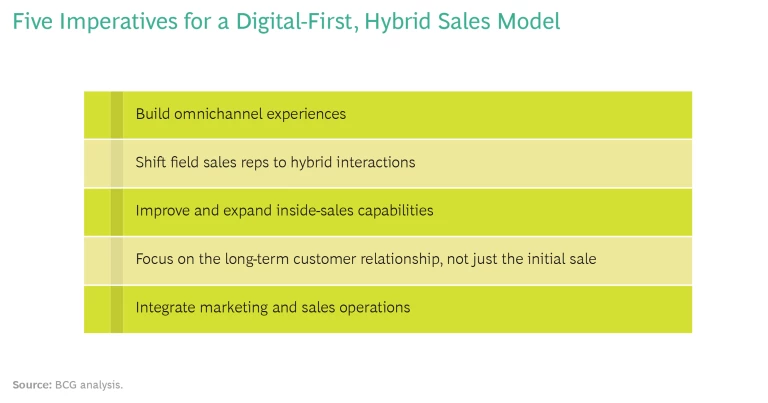As COVID-19 restrictions gradually fade, B2B businesses want nothing more than to get back to normal. That’s understandable, but getting back to normal should not be the goal. In fact, it isn’t even possible. A recent Salesforce survey made that clear: 58% of reps believe their role has been permanently altered. The pandemic—and the required shift to remote, digital interactions between buyers and sellers—exposed major challenges to the old commercial approach. It also unearthed new opportunities.
Some companies think they can apply lessons from the past year in incremental ways while largely sticking to their existing commercial model. We believe the situation calls for far greater ambition. Companies need to take those lessons and develop a systematic approach to digital sales by building the right customer-facing processes and internal infrastructure. This will not only ensure increased efficiency but also spur business growth.
There’s no going back to the status quo ante. But companies have an opportunity to capitalize on the way that buyers and sellers are functioning now—and will continue to function in the future—by digitizing sales channels, building hybrid sales teams, and creating a true omnichannel experience for customers.
The Value of Digital
COVID-19 was a massive disruption, yet for commercial businesses, it accelerated changes that were already underway. Before the pandemic, top-performing organizations relied on digital channels to serve customers. In fact, many customers used digital self-serve solutions to research products and services before they ever interacted with a sales rep. But the commercial processes at many B2B organizations were still based on traditional sales methods—primarily oriented around field sales reps traveling to see clients in person.
The pandemic changed that by forcing remote interactions and demonstrating the value of digital experiences to both buyers (who enjoy better response times with more frequent communication) and sellers (who eliminate travel time and can use data to improve performance). The upside of this new digital-first selling environment is clear to sales teams: according to a BCG survey of more than 250 sales reps across leading companies in several sectors, fewer than 50% expect to return to the office or resume traveling full time.
Quite simply, digital needs to be at the forefront of every customer interaction. Sellers must offer engaging and intuitive e-commerce solutions to buyers across the entire customer experience, from initial research to the transaction to postsale service. Throughout, sales and marketing leaders should use digital to better understand the performance of their teams and make smarter, data-driven decisions with respect to both improving execution and managing people.
Field sales are not dead, however. While digital is undoubtedly leading the way in sales calls and customer communication, there will be some need for in-person engagement in the years ahead. It’s critical for businesses to examine their customer base to understand where such interaction is still necessary and how it can work seamlessly with digital outreach.
Five Imperatives
Creating a digital-first, hybrid sales model is an all-hands endeavor. It requires redesigning processes, implementing technology, and changing the culture in sales and marketing organizations. To break that task down into manageable chunks, we believe that management teams should focus on five imperatives. (See the exhibit.)
Build Omnichannel Experiences
In the past, sales channels often operated in isolation. The various units focusing on field sales, inside sales, e-commerce, and indirect sales through distribution partners guarded their own customers—or transactions—fiercely, largely because their compensation and incentives were set up that way. This approach creates an extremely disjointed experience for customers.
Today, customers expect to engage with businesses across all sales channels in an integrated way. That even includes switching among various channels during the course of a single transaction. For example, the “learn” part of the customer journey typically occurs online. But customers often prefer to speak to an inside-sales rep to address technical questions and to access the best possible discount when they’re close to making a decision.
In recent years, this omnichannel model has been used primarily by small and medium-size customers, with enterprise customers using it only for smaller, add-on purchases to supplement a larger transaction. Today, we’re seeing enterprise customers lean more heavily on omnichannel experiences. It’s not uncommon for corporate customers to use self-serve digital channels like online ordering systems to make large, seven-figure purchases for preconfigured or repeat orders. Take telecom infrastructure , for example. Once a site has been fully configured for internet or phone service, large players typically prefer to make transactions via intuitive online ordering systems rather than interact with a sales rep in person or on the phone.
Delivering an omnichannel experience requires companies to think less about their internal processes and fiefdoms and more about collaborating in a customer-centric way. Roles need to be realigned around helping customers solve problems, removing friction, and increasing customers’ lifetime value. Incentives—which have typically rewarded individual transactions—need to be restructured and responsibilities clearly aligned with customer-centric goals and metrics. To support this, customer interaction data from all channels must be linked internally for easy access.
Delivering an omnichannel experience requires companies to think less about their internal processes and fiefdoms and more about collaborating in a customer-centric way.
A Fortune 100 B2B services player is a good model for what’s possible. The company recently improved its omnichannel experience, including a redesign of the digital customer journey with options to transition from online to offline interactions. The company also invested in new tools and training to help its more than 500 sales reps convert leads in a hybrid sales environment, while aligning scorecards and incentives across the marketing and sales organizations. Within three months, the company doubled its close rate.
Shift Field Sales Reps to Hybrid Interactions
The era of old-school “road warriors”—field reps who traveled to client sites 280 days a year—is over. In-person visits can be effective but, given recent advances in digital connectivity, they are also highly inefficient and often unnecessary. Some aspects of sales will likely always happen face-to-face with field reps, but COVID-19 showed the value of remote, digitally enabled interactions.
To shift from field work to hybrid interactions, companies must empower field sales reps with new digital tools, such as analytics-enabled CRM systems that can deliver insights from all sales channels. Additionally, artificial intelligence, already common in sales CRMs, should be used to suggest the next action in a sales cycle. Supplementary training and mobile tools can support these actions, showcasing opportunities across a pipeline.
Companies must also be more explicit about which aspects of the customer experience can or should happen in person, rather than leaving that up to the discretion of reps. More structured calendars and timelines will help, along with targeted training in new skills, such as how to deal with customer objections over the phone, rather than in the room.
Supporting functions such as sales operations and management will need to change as well, given that reps’ daily routines, processes, and performance metrics will become more data driven. These shifts are difficult for reps accustomed to traditional in-person sales models. In fact, a BCG survey of more than 50 large companies identified big challenges in the shift to inside sales. Some 78% of respondents cited maintaining employee motivation and morale as an issue, and 58% were concerned about the lack of on-the-job training for people working from home. The ideal solution combines regular coaching with intuitive, easy-to-use technical tools that minimize rep frustration.
Some aspects of sales will likely always happen face-to-face with field reps, but COVID-19 showed the value of remote, digitally enabled interactions.
Before the pandemic, a leading Europe-based provider of cleaning products and services relied primarily on in-person sales, and it was significantly affected by COVID-19 restrictions. To adapt, it launched an inside-sales pilot in just four weeks, leading to a 6-fold increase in offers and a 12-fold increase in productivity (measured in terms of customer outreach). The company is now scaling the pilot to build a hybrid team for its full sales force of several thousand reps.
Improve and Expand Inside-Sales Capabilities
Before COVID-19, inside-sales teams were treated like the junior varsity. Inside selling was the less sexy career path, with reps relegated to servicing smaller and less important accounts and transactions. In the past year, however, virtually all salespeople have been working remotely. Initial pitch meetings, quarterly business reviews, and postsales support are all happening in digital environments.
In fact, the potential of inside selling is one of the biggest lessons of COVID-19 for commercial operations. Now, companies can build on virtual-sales momentum and create larger and more adept inside-sales teams capable of managing more of the customer journey. This expansion involves two fundamental shifts, one in role responsibilities and one in expertise.
First, inside reps should gradually receive larger and more important accounts. With travel demands gone, they have more time to manage clients with nuanced, complicated needs. Some companies are creating more specialized roles for reps, or are aligning them with specific industries or segments to better meet heightened customer expectations. These measures would have had significant cost implications in the pre-COVID world because of added travel requirements, but they are far more viable under a hybrid model.
Second, reps should be trained to manage more of the customer journey. Thanks to the automation of lead generation in all-in-one CRMs and the instant communication afforded by virtual selling, they can focus on building a relationship with each customer instead of chasing prospects. This requires a shift in organizational thinking. Instead of prioritizing in-person or event-based marketing (such as buying a table at a trade show), B2B businesses need to maximize their digital impact.
Critically, inside reps can also meet the growing requirement for specialized technical and product expertise. Many businesses, especially those with large product portfolios, have dedicated experts with a deep understanding of specific products and services and how they can be used to improve performance. In the past, these experts were deployed in the same way as field sales reps. Today, there is a growing opportunity for companies to make reps into product experts who can leverage virtual communication to provide customers with one-stop guidance on sales and product functionality.
The potential of inside selling is one of the biggest lessons of COVID-19 for commercial operations.
As one seller told us, “If I offer my customers a chance to engage with our best expert on a given topic over video or to have another person who’s pretty good come out and meet them in person, they always pick the first option.” Expertise wins. Another case in point: at a leading global B2B services player, the field sales team was only converting about 1% of digital leads. To improve, the company conducted a pilot inside-sales program with approximately 200 reps, ramping up product training to boost rep expertise. The initiative increased the conversion rate roughly ten-fold, generating more than $100 million in incremental annual recurring revenue.
Focus on the Long-Term Customer Relationship, Not Just the Initial Sale
Yet another lesson from COVID-19 has been the power of a company’s existing customer base. During the pandemic, the share of a seller’s revenue that came from current buyers far outstripped revenue from new accounts. Some sale leaders theorize that this was because buyers focused more on business continuity than on expansion. Regardless, the key takeaway for sellers is that an undue focus on closing transactions is giving way to a new sales approach based on long-term relationships and lifetime value.
There is a clear economic argument for such an emphasis: it costs far less to maintain an existing customer relationship than to create a new one. Another relevant factor is new business models that offer buyers different types of services and offerings, typically for a recurring payment like a subscription. For example, a developer that in the past would buy elevators for its buildings can now also buy subscription-based telemetry services that use data to predict when the elevators will require maintenance.
Given this pivot, sellers need to focus on managing relationships over the long term, which naturally changes internal roles and responsibilities. The past 18 months have seen an explosion in the number of companies creating a customer success function, with managers or sales ops leads holding reps accountable for customer satisfaction.
An undue focus on closing transactions is giving way to a new sales approach based on long-term relationships and lifetime value.
To succeed at scale, those overseeing customer success must be far more proactive, especially in using data to anticipate unmet customer needs, identify opportunities for cross-selling and upselling, and address customer churn. Armed with clean data, a company can allocate resources to customers that present the biggest opportunities for growth and the biggest risk of leaving. A leading animal health company, for instance, built an AI-enabled call-planning tool to generate recommendations on cross-selling and upselling to existing accounts while also reducing churn. This effort led to a $45 million increase in annual sales.
Integrate Marketing and Sales Operations
Historically, sales, marketing, and service teams have been supported by their own operations teams, each utilizing different processes and platforms. In the future, these elements will have to come together. Ideally, this will occur through a high-level revenue operations role that creates and manages company-wide revenue and promotion strategies.
This kind of managerial change is not always possible for smaller companies, however. At a minimum, operations managers need to be aligned across B2B sales, marketing, and service teams, evolving from back-office sales support staff to strategic leaders tasked with increasing sales efficiency, marketing impact, and product value. Also, marketing and sales ops teams must use the same platforms with the same metrics, incentives, and planning rhythms. For example, if a company decides to invest heavily in a marketing campaign, that effort should be coordinated with sales operations in order to accommodate increased demand.
In the future, sales, marketing, and service teams will have to come together.
Technology is a key part of this alignment. As sales channels become digitized, there is an opportunity to automate key processes across marketing and sales teams. Currently, tasks such as issuing a quote, generating a report, and managing quality control are cumbersome and often manual. An all-in-one CRM with marketing tools and workflow automation can solve some of those headaches for frontline sales and marketing teams, enabling them to focus on value-creating work. The result will be increased efficiency and a better experience for employees and customers alike.
How to Get Started
The imperatives described above are big-picture elements to address over time. To get started, companies should focus on the following immediate measures:
- Set policies for hybrid work. As your company returns to in-person work, you’ll need to set clear policies about how that will look, including expectations on work location, customer visits, and the management of larger-format events. These new policies create an opportunity to consider changes to the physical footprint, technological tools, and core processes. As an example, some companies are shifting to a more regional, sales “minihub” model, allowing them to close some sales offices.
- Identify key metrics for measuring success across the customer journey. In order to more tightly align customer touchpoints across marketing, sales, success, and support efforts, identify a set of guiding metrics to assess key outcomes across the customer journey. As a starting point, establish the leading indicators and outcome measures for each customer segment, product, and life cycle stage (for both new and existing customers). Once you have this information, it’s important to incorporate it into the data and reporting tools needed to provide all stakeholders with a single view.
- Rethink customer segmentation and consider more hybrid or inside-sales roles. After a year in which nearly every seller became a remote seller, now is the chance to rethink how you cover accounts. This process starts with a thoughtful segmentation effort, taking into account the needs and value potential of specific customers, along with your ability to reach them across channels. Consider opportunities to increase the base of customers you serve with a primarily hybrid or inside-sales effort, which can deliver a better customer experience (more frequent engagement) at lower cost (reduced travel expenses).
- Close critical omnichannel gaps. Your customers want an omnichannel experience spanning how they learn about, buy, and use your products and solutions. Consider your customer’s complete buying journey and, where you see gaps, the ways in which you might improve, such as by providing a better web experience to differentiate your products for a technical audience or a self-serve customer portal to manage orders.
- Invest in training and focus on team morale. The digital-first hybrid work environment can leave sales teams feeling isolated and unprepared for a new way of selling. To avoid frustration and poor morale, spend extra time on training and coaching. Ensure that training is designed for a digital-first world (interactive, focused, multimedia) and is tailored to the needs of individual reps based on their tenure and on real-time data on the challenges and opportunities they face. It’s also critical to go beyond training to rethink events aimed at building morale.
- Listen and be agile. Your teams, customers, and partners are all evolving quickly to adapt to the new normal. There will be false starts and stumbles ahead. This is a great moment to ensure that you have feedback channels (such as surveys and forums) that can give you an understanding of what’s working and what needs to change. Additionally, foster a flexible mindset so your team can adapt to any new changes. The ability to quickly respond and change direction will be critical to ongoing success and resilience.
One of the biggest lessons from COVID-19 has been the success of remote, digitally enabled B2B sales. This development has not only resulted in greater effectiveness, it has opened the door to better customer experiences. For sales leaders, the challenge is to capitalize on the shift and resist the temptation to revert to old ways of working. As we look to the future, businesses of every size should invest in a true omnichannel sales model, while training their teams to manage longer-lasting—and more profitable—customer relationships.







